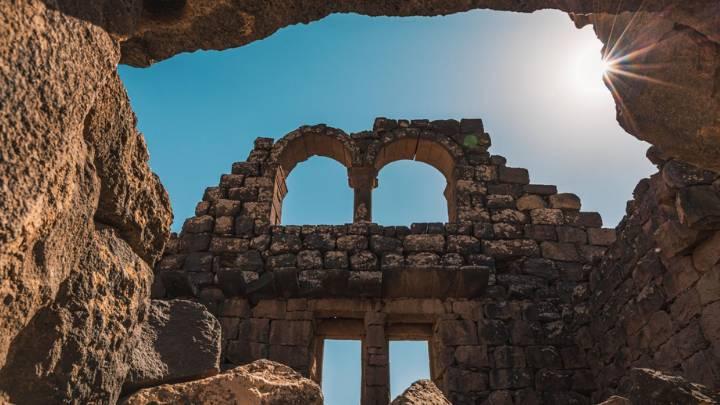Fulbright Award unearthing deeper beauty at the ruins of Umm Al-Jimal

“Our world is a world that was created perfectly, and we have clues, and we have signs of that beauty, that glory, but we can’t see the whole picture,” said Darrel Rohl, associate professor of history and director of the archaeology program at Calvin University. “Our world lies in ruins, our lives in ruins. There’s beauty amongst the ruins though.”
For the past half century—52 years to be exact—the Calvin University community, led for many of those years by the late Bert de Vries, has been discovering the beauty of Umm Al-Jimal, an ancient site and modern community in the country of Jordan. The Calvin team has worked closely with the local people and municipalities to map, maintain, and make the ruins at Umm Al-Jimal more accessible.
Dream job
Rohl first encountered de Vries and the ruins while a student at another university back in the early 2000s. He remembers telling his wife he wanted to dig at Umm Al-Jimal someday. He remembers being inspired by de Vries and enamored by the beauty of the ruins.
“Ruins are amazing because ruins show us enough of what it used to be like,” said Rohl. “They are reflections of a perfect whole that once existed.”
Digging deeper
Two decades after Rohl initially visited the site, he has the opportunity to do something never done there before. Through a Fulbright scholarship, beginning in September 2024, he will spend 10 months doing 3-D laser scanning of the nearly 200 ancient structures at Umm Al-Jimal. This will create the most precise and accurate three-dimensional understanding of the ancient ruins as they currently exist.
Rohl says the scanning will allow him to get down to 15-millimeter resolution, whereas most of the current archaeological drawings aren’t even at the 1-meter resolution in terms of accuracy.
“This is going to allow us to have a really fine-tuned understanding of each structure,” said Rohl.
Creating opportunities, preserving history
Rohl sees this creating great opportunity not only for students at Calvin, but also for students of history at all grade levels, all over the world.
“Rather than showing students still photos, drawings, or videos of the site, we can actually stand in the middle of the structure and walk through rooms. We can rotate and look up at the ceiling,” said Rohl. “It’s the closest thing to physically being here without physically being here.”
He sees this also as a great benefit to researchers, like himself, who will have access to sub centimeter accuracy of the current condition of structures that date back 2,000 years in some cases.
“We are able to capture this site at a detail never before available and will be able to preserve those views and knowledge before any further ruination occurs,” said Rohl.
In many ways, what Rohl will be creating is a comprehensive 3-D model which will form the baseline for all future conservation management.
“Each of those 3-D scans that get produced can then be compared with each other and so we can quite readily identify any change that has occurred,” said Rohl. “That might include a leaning wall, maybe the wall has only slightly started leaning. We might not be able to see that with our naked eye, but the 3-D scans can reveal that information to us.”
Loving both the place and the people
While preserving the ruins is the tangible goal of this project—the “why” behind it goes well beyond preservation of structures.
“As Bert de Vries spent time, year after year in this community of the living people, today’s inhabitants of Umm Al-Jimal, he began to realize that the work he was doing and the ruins that he was exploring and the past that he was so fascinated by wasn’t the only thing of value at this place,” said Rohl. “And over time he not only fell in love with the ruins and the romance and the mystery of the site, but with the people who he worked with here, who he had to rely on, who welcomed him into their community and showed him such great hospitality.”
Rohl’s journey at Umm Al-Jimal has been similar, and he’s now excited through this Fulbright to allure more people into the full beauty of this place and its people.
“I see the work we do archeologically as us being agents of renewal, of restoration, not rebuilding the structures, but restoring the knowledge that’s been lost from those structures by really paying attention to the details, by excavating and examining every square inch,” said Rohl.
“I absolutely love what I do as an archaeologist, but to some degree the work I am doing as an archaeologist is almost more deeply driven by my desire to see improvements in the lives of the people who live here and the local community,” said Rohl.
For Rohl, the best outcome of a project like this would be for people to be allured to want to experience Umm Al-Jimal for themselves.
“There’s this deep emotional feeling you get when you see this place and walk through it,” said Rohl. “I hope that this 3-D scanning we do serves as a means to allure people to this site, to engage with the community, and in so doing experience an emotional connection that everyone who comes here feels.”






